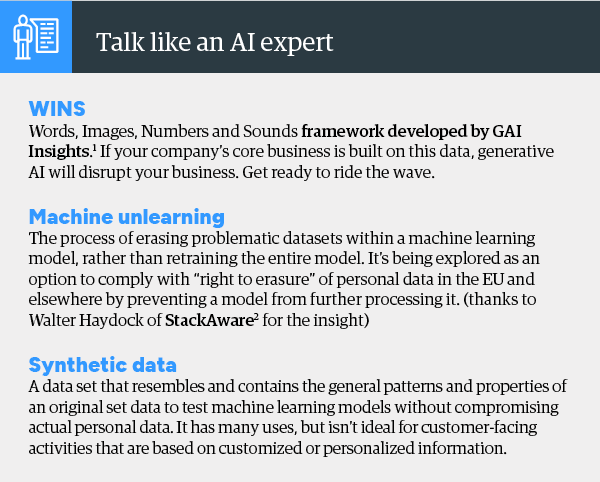What do music festivals, real estate developers, and the Caribbean island of Anguilla have in common? They all have been greatly impacted by the explosion of generative AI, with no signs of slowing down.
They are part of the AI long tail, where the technology’s explosive growth reverberates and ripples in unexpected ways. And they are just some examples shared by AI experts and practitioners at the recent GAI World conference in Boston.
“AI helps people expand the practical imagination space,” said Dr. John Sviokla, founder of GAI Insights, which hosted the conference.
AI winners and losers
The biggest AI use cases right now are for customer service and document summaries, UBS Stock Analyst Lloyd Walmsley told the audience. And companies have many different experiments going on showing real promise in several areas, he added. Tech stacks and cloud computing need upgrades. There is new demand for networking across the enterprise to transmit data. Customer data foundations must be in place. And then there are the ripples beyond the IT world.
Which brings us back to Anguilla, a tiny island of only 35 square miles in the Eastern Caribbean with a population of about 15,000. I learned at the event that the island nation owns the country domain “.ai” and is poised to generate more than $35 million in domain name registry revenue in 2023, according to Bloomberg. That’s a 5x boost in revenue since 2021, thanks to so many new AI startups launching this year.
Another unique player in the AI boom is the real estate industry. Nadia Lovell, senior U.S. equity strategist at UBS, said at the event that more than 30% of company earnings calls this year referenced AI. Tech companies led the way, followed surprisingly by real estate firms, she said. As AI needs grow, companies need more data centers and cooling facilities, which requires larger real estate investment.
The butterfly effect on human development
The ripples extend to humans as well. Boston University Associate Professor Gordon Burch explained that Large Language Models will be used in the short term to support information-based tasks like debugging code, researching topics, or explaining how to do something. This removes the need for employees—particularly junior employees—to collaborate with others in their workplace community to gain knowledge and expertise.
“Forming employee connections is important, especially for younger employees,” he said. “When using AI, be careful to manufacture opportunities for peers to engage and interact.” It will be up to companies to intentionally foster employee engagement and community that will otherwise disappear because of AI.
On the flip side, the breadth of digitization has pushed people to seek out more human experiences. Sviokla pointed to the growth in music festival attendance as a good example. “There’s a natural tension between the digital and human worlds,” he said. It’s important to strike a balance with human-centered experiences, supported by digital tools, to give people an analog outlet to counteract expanding virtual experiences.
And with the rise of AI, it’s essential to bring current employees along with the right tools and reskilling, said Joe Atkinson, vice chair, U.S. chief products and technology officer at PwC. Atkinson helps lead PwC’s $1 billion investment in GenAI and digital transformation, with a large portion allocated to developing the “next generation of workers.”
“We need to prepare our people to use GenAI or else we are leaving them in harm’s way,” he said.

Sources: GAI Insights, StackAware

